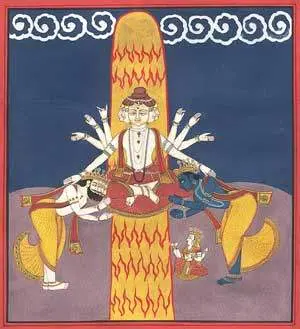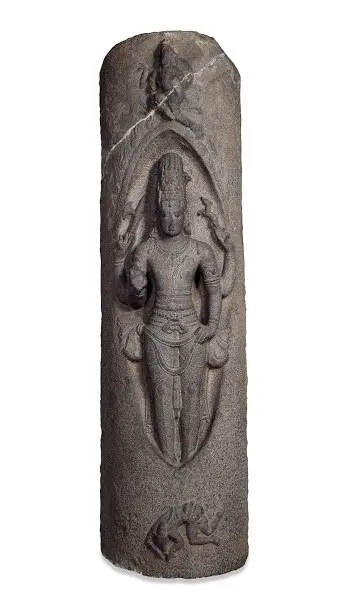Lingodbhava (emergence of the Linga) is the story of the origin of the Shiva lingam. It is also an iconic representation of Lord Shiva. The Shiva lingam is his aniconic representation. The story of Lingodbhava is mentioned in many Puranas including the Linga Purana, Shiva Purana, Kurma Purana, Vamana Purana, Skanda Purana, Brahmanda Purana, and Vayu Purana with slight variations. This is also the story of the birth of Lord Shiva.
The Lingodbhava Story in the Linga Purana (1.17.6):
At the end of the Kalpa (a period of 4.32 billion years), there was only a single vast sheet of water. Lord Brahma saw Lord Vishnu having a yogic sleep on the bed of Shesha (a serpent deity of Hindus). He woke him up with the blow of his hand and asked him who he was. Lord Vishnu told him that he was the creator, sustainer, and destroyer of the world. It infuriated him because he believed he was the creator, sustainer, and destroyer of the world. Then they got into an argument about who was superior.
The argument turned into a furious fight, and then suddenly a Jyotirlinga, a huge infinite pillar of light, appeared in front of them. It had thousands of clusters of flames. Also, it had no beginning, middle, or end. It was the source of the universe. They were deluded by it. They forgot their fight and decided to test it. Lord Brahma assumed a form of a swan and went upwards. Lord Vishnu took the form of a wild boar and went downwards.
They both traveled for one thousand years but could not find the end of the lingam. Therefore, they returned to where they started. They bowed to the lingam and wondered what it was. Then a loud sound “Om” came out of the column, and the letters “अ” “ऊ,” and “म” (“a,” “u,” and “m”) appeared on the lingam. Above those letters, they saw Lord Shiva along with the goddess Uma. Lord Shiva told them that they both were born out of him, but they had forgotten about that.
The day this incident happened is celebrated as Mahashivaratri (the Great Night of Lord Shiva) by Hindus.
The Lingodbhava Story in the Shiva Purana (1.17.6):
The story in the Shiva Purana is nearly the same as mentioned above except for a few additions.
Lord Vishnu accepted that he could not find the end of the lingam, but Lord Brahma lied. He said, “O Hari, the top of this column has been seen by me. This Ketaki flower is my witness.” The Ketaki flower repeated the falsehood endorsing the words of Brahmā in his presence. Lord Vishnu, taking it to be true, made obeisance to Lord Brahma. He worshipped Lord Brahma with all the sixteen means of service and homage.
Upon hearing and seeing this Lord Shiva got upset with Lord Brahma, and he created Bhairava from his eyebrow hair to punish him. Bhairava cut one of the five heads of Lord Brahma that was guilty of lying. Seeing this, Lord Vishnu felt pity for him and requested Lord Shiva to forgive him. Lord Shiva accepted his request and spared the life of Lord Brahma, but as a punishment, he prohibited his worship. That is why Hindus do not worship Lord Brahma.
He also punished the Ketaki flower for perjury. He banished it from his worship. This is the reason Hindus don’t use the Ketaki flower in Lord Shiva’s worship.
Pleased with the truthfulness of Lord Vishnu, he gave him equal status as that of him.
Reference in the Vedas:
Many stories in the Puranas are elaborations of the hymns in the Vedas. The root of this story is in the Atharvaveda.
There is a hymn in the Atharvaveda (X-7) sung in praise of the Yupa-Stambha (the sacrificial post), in which a description is found of the beginningless and endless pillar. The sages used to perform a yajna (a ritual performed in front of sacred fire) to propitiate gods. Many scholars believe that the yajna fire, its smoke, ashes, and flames, the Soma plant, and the ox that used to carry on its back the wood for the fire, gave place to the conceptions of the brightness of Lord Shiva’s body, his matted hair, his blue throat, and the bull as his carrier.
Iconography:
This image combines the aniconic form of Lord Shiva with his image. Images of Lingodbhava are popular in the southern part of India, and Shaiva temples normally have this image on the exterior walls of the temples.
The Scientific Meaning of the Story of Lingodbhava:
In the story of Lingodbhava, it is mentioned that before creation, Lord Brahma and Lord Vishnu were quarreling over superiority. Then suddenly from nowhere, a column of fire appears in between them, and Lord Shiva and the goddess Uma come out of it. Lord Shiva tells them that they have forgotten that they are born out of him.
After reading this story, several questions come into mind. If there was nothing, then where were those gods standing, and where was that column of fire located? Why were gods fighting for superiority?
Clues to Solve this Puzzle are in the Names and Hindu Iconography:
In this story, Lord Brahma is symbolically represented as the universe (Brahmanda), Lord Vishnu as the matter [Vishwa (world) + Anu (atom)], Goddess Uma or Shakti as the energy, and Lord Shiva as a black hole!
The symbol of the lotus is of great significance in Hinduism. Lord Brahma is mostly depicted as sitting on an opened lotus flower coming out of the navel of Lord Vishnu. A lotus bud looks like Hiranyagarbha. A lotus has 18 petals, and 9 (1+8) is a sacred number in Hinduism.
Therefore, Brahma coming out of a lotus actually symbolizes Brahmanda, i.e., the universe.
Lord Brahma, born out of the lotus coming out of the navel of Lord Vishnu, symbolizes Brahmanda is made up of matter.
In this story, Lord Shiva is depicted as superior to Lord Vishnu and Lord Brahma, and Lord Shiva says that they were born out of him. He says so because matter and the whole universe were created (born) out of a black hole. The column of fire is the blast coming out of the exploded cosmic egg. As it was traveling at the speed of light, Lord Brahma and Lord Vishnu could not find its end. The AUM sound was produced at that moment. Therefore, the Shiva lingam represents the moment of creation.
Therefore, the Lingodbhava story or the Shiva lingam actually represents the moment of creation.


Nicely written article..
little bit more may be added. ” Linga puranam says that Shiva ( = Brahmam) created Vishnu & Brahma ( by dividing him i.e. the Brahmam…Infinity minus infinity is infinity “”Om purnamadah purnamidam purnat purnamudachyate
purnasya purnamadaya purnamevavashisyate
Om Shaantih Shaantih Shaanti.” translates roughly ‘Taking Purna from Purna, Purna Indeed Remains (Because Divine Consciousness is Non-Dual and Infinite)’ )….that’s why both vishnu & Brahma felt that they individually were carrying out the 3 tasks ( creation, sustaining, destroying ). Subsequently Shiva created Ahankar ( ego = Maya) and also , senses etc. ( Vishnu & Brahma were not aware of this event). This Ahankar ( ego) entered into Vishnu & Brahma, which led to the contest…Later when shiva explained that he created Ahankar both Vishnu & Brahma realised what has happened. Thereafter all the 3 were of the same wavelength and were again aligned with the original Brahmam. After this, the trinity have formed Atmans of living beings from the original Brahmam. So we have the Original Brahmam ( i.e. Shiva, vishnu, Brahma ) which is ‘Anadi ( eternal). so is the ‘Maya’ – the delusion is Anadi. So are the Atmans of living beings created are Anadi..( Shaiva siddhantam says..Pathi ( Shiva), Pasu ( Atmans), Pasam ( Bondage, delusion, Maya) Anadi ( eternal)